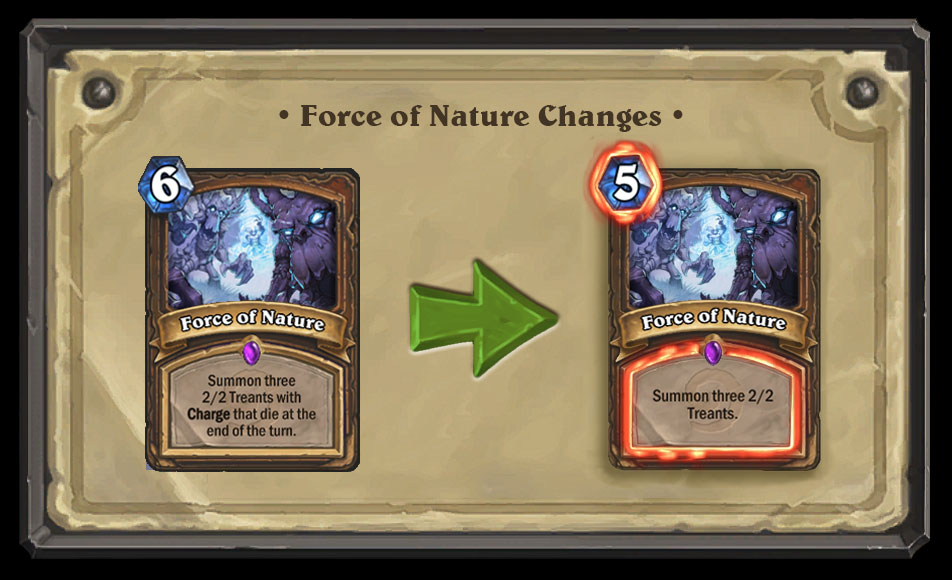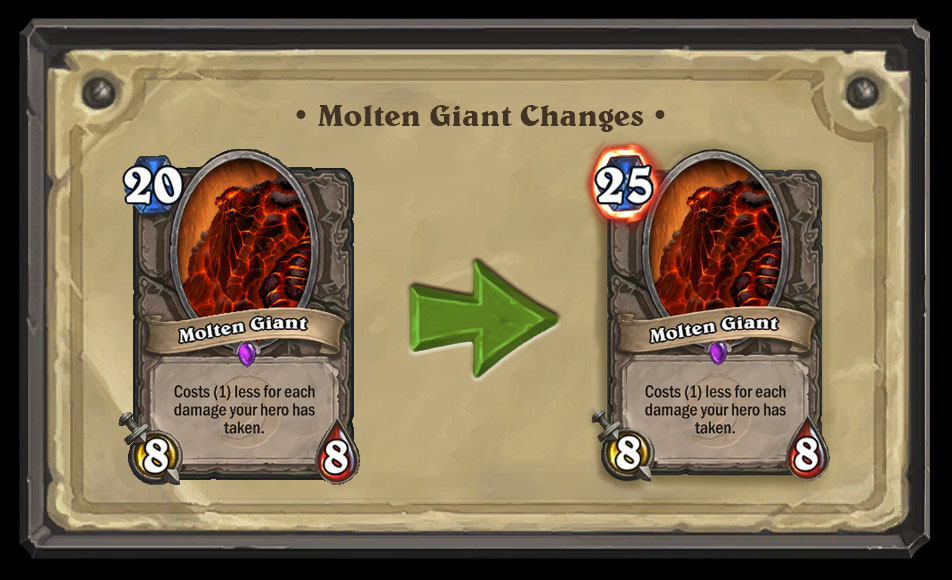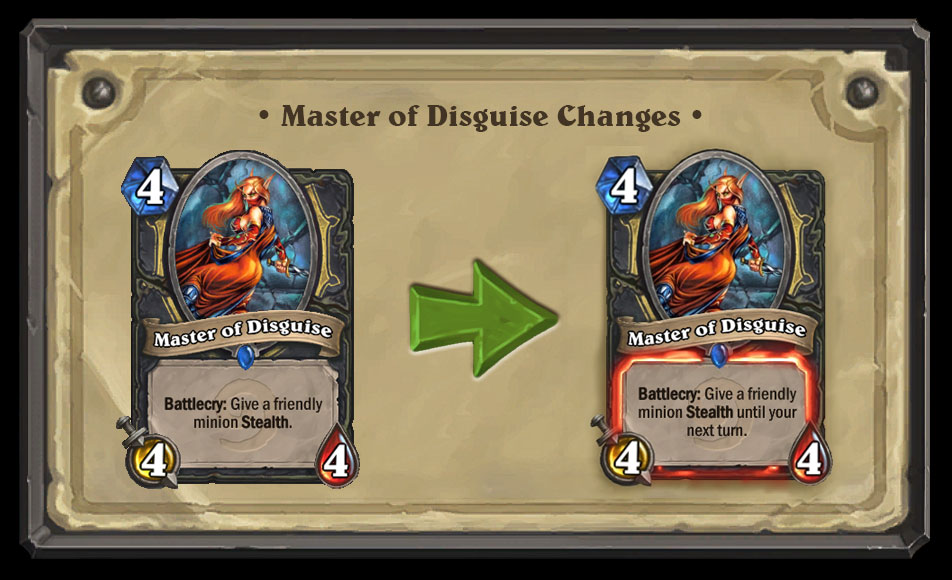Playable or not? Analysing the latest Hearthstone nerfs in detail

I've got the old cards in my sights...
Normally, the excitement surrounding a Hearthstone expansion comes from seeing what crazy new effects the designers have come up with and theorycrafting innovative decks to play once the cards arrive. The launch of Whispers of the Old Gods, and with it the introduction of the Standard format, however, has almost been overshadowed by the promise of numerous nerfs that will be made to cards from the Classic and Basic sets in order to prevent them from dominating the game in perpetuity, or limiting future design space.
And so, over the past month, almost every single Hearthstone player will have said something along the lines of: “Man, I hope this nonsense gets nerfed in Standard”. Today the wait is over, and the juicy info is at our fingertips. In this gallery I'll take a look at the likely impact of each of the changes, and try and expand on Blizzard’s thinking as to why these cards (and not others) had to feel the sweet kiss of the nerfhammer.

Ancient of Lore
To the surprise of precisely nobody, we start with Druid. Ancient of Lore is objectively one of the highest value cards in the game. The issue with Druid decks is that they often dump their hand to get a criminally unfair advantage thanks to playing Innervate and Wild Growth early on, and then use Ancient of Lore to refill too effectively. With this change, Druids will find drawing more difficult—so if you can overcome their fast starts, starving them out of the game becomes a more viable strategy. When the board state was closely contested, Ancient of Lore often tipped the balance in the Druid player’s favour by allowing them to out-resource you in the late-game.
Even today, Druid decks often run additional card draw effects like Azure Drake in order to support the inclusion of low Mana cards like Living Roots. If those players hope to continue with that strategy, they’ll need to find a new source of card draw. In a vacuum, Ancient of Lore is still just about playable. The Healing effect remains powerful and needed in many situations, and with the removal of Antique Healbot from the format, Druid doesn’t have many great alternatives outside of awful cards like Healing Touch and Tree of Life.

Force of Nature
Rejoice fellow cardslingers! The Druid combo is dead! For far too long players have suffered at the hand of the dreaded 14 damage from an empty board, but the angry trees are about to be thrown into a wood chipper. In the past Blizzard has shot down various other combo decks on the basis of them being “not fun or interactive”, but somehow Druid skated along unharmed. That changes next week.
Choosing to address the Force of Nature half of the package over Savage Roar makes a lot of sense, because losing the latter might have been too damaging to the class overall. At various points in Hearthstone’s history we’ve seen other midrange decks flirt with dominance in the meta, but the likes of Dragon Priest and Midrange Paladin suffered from the lack of explosive finishers when it came to closing out games.
Keeping Savage Roar intact will continue to reward Druid for maintaining board control during the midgame, but removes the idiocy of dying from an empty board.The new Force of Nature is a reasonable card—6/6 of stats in an awkward distribution is acceptable value for 5 Mana—but its overall weakness to standard AoE spells like Consecration and Holy Nova will probably be enough to rule it out from serious play. Even the lowly Silver Hand Knight arguably represents a stronger stat distribution overall.

Keeper of the Grove
A severe nerf to a powerful card. Silence has been hit hard in Standard with Ironbeak Owl also finding itself in the firing line. Amazingly, Spellbreaker seems to have escaped unnoticed. So, when comparing Keeper and Spellbreaker, the question becomes is the flexibility of a 2 damage Battlecry worth a -2/-1 drop in stats? The answer is probably not. The most useful matchups for the instant damage from Keeper were against aggro decks where the 2/4 body could go on to contest multiple minions. Now, with its subpar stats, it’s not going to stick around to fight for board control. The upshot is that if you feel like Silence is necessary in your deck, you’ll probably just end up running Spellbreaker.
In combination, these three nerfs to Druid class cards will go a long way towards reducing the power of the Midrange Druid archetype which had clearly become too much of a terror to the game, and has seen little innovation over the course of multiple card sets. This is important to note because Druid is being given some strong new options in Whispers of the Old Gods, including Mire Keeper and some excellent C’Thun-related cards. That probably means Druid decks will have to polarise in one direction or the other, resorting to outright Aggro or extreme late-game Control.

Ironbeak Owl
Farewell, sweet feathery friend. Clearly there is a feeling on the Blizzard design team—and which is echoed by many competitive players—that having supposedly powerful buff effects, Deathrattles and Taunts made instantly irrelevant by a hoot-hooting 2-Mana card isn’t much fun and shouldn’t remain in the game. However, the strange part of this nerf is again the cost comparison with Spellbreaker.
The need for a cheap Silence effect in your deck is lessened by the fact a lot of the cheap Deathrattles are being removed from Standard. Right now, Ironbeak Owl for 2 Mana is excellent against Hunter and Zoo, since it trades evenly with almost all of their 2 Mana options. With that factor removed, and with the increased Mana Cost, there seems little reason not to just run Spellbreaker in your deck instead.
Even in Face Hunter—a deck that can often take advantage of the Ironbeak Owl’s Beast tag as a Kill Command activator—the increased cost probably hurts too much. Ironbeak Owl, Kill Command and Hero Power will cost 8 Mana, meaning that on any turn before eight, the Beast tribe effect is mostly irrelevant since you will be forced to miss out on a Hero Power anyway.

Big Game Hunter
Here’s the most correctly predicted nerf of them all. Almost every experienced Hearthstone player could see the problem that Big Game Hunter presented, both in terms of maintaining the fun feel of the game, and limiting future design space available to the designers. Big Game Hunter essentially forced any huge late-game minion you wanted to include in your deck to impact the board immediately, otherwise getting hit by a BGH on the following turn was often game-losing.
Increasing the cost of BGH to 5 Mana means that the Tempo swing from destroying a huge target will be much less severe, and gives players a lot more freedom to put huge minions in their decks. This seems particularly important with the Old Gods theme of the new expansion introducing multiple 10-Mana monstrosities.
The hits being taken by these key neutral removal cards has some serious potential implications. BGH costing 5, and the nerf to Ironbeak Owl, means that there will rarely be a solid answer to a huge Edwin Van Cleef made early on in the game by Rogue players. Similarly, a big double-Innervate play from a Druid will have no on-curve answer outside of class removal spells like Hex, Polymorph and Execute. Those scenarios don’t occur that often, but could still cause issues down the line if left unchecked.

Hunter's Mark
Another card that is the cause of much frustration, Hunter’s Mark continues the theme of Blizzard addressing cards that are resoundingly anti-fun. Interactions between huge minions is (from Blizzard’s perspective, at least) one of the most enjoyable parts of the game, and something that newer players generally thrive on. The feeling of putting your newly unpacked legendary minion into your deck only to have it removed effortlessly is terrible, and so it’s no surprise to see Blizzard taking steps to deny huge tempo cards like this, especially in a meta in which tempo is so important.
Hunter is a class that thrives on tempo overall, so whilst a card like this might be fine in a class like Warrior (See: Execute), it’s incredibly destructive in a class that is built around gaining advantages from pushing board advantage. Gaining a 5-6 Mana advantage from removal via Hunter’s Mark, and then playing minions, might be a recoverable situation against many classes—but against the relentless aggression of Hunter, it spells certain doom.
Again, the new expansion is heavily themed around decks that build towards the focal point of playing a huge minion. If these huge creatures can be removed from the board too efficiently, then the whole set has the potential to fall flat on its face. And no one wants another Grand Tournament whiff. In Face Hunter, Hunter’s Mark is almost certainly superior to paying for the new overcosted Silence effects if it was left at 0 Mana. At a price of 1 Mana, there will be heavy experimentation to see what the correct solution for aggressive decks is.

Blade Flurry
Blade Flurry was not a card that many people were expecting to get hit. It was clear to the eagle-eyed observer that Rogue would have to see some adjustments since it was losing very little in the new format. Personally, I expected any changes to centre on Preparation. Prep is a zero-cost spell, which is always a warning sign, and the engine that enables a lot of the most destructive Rogue plays. The huge early Edwin Van Cleef mentioned earlier is usually only possible by comboing Prep with another spell. Blizzard have seen things a different way, though, and chosen to alter Blade Flurry instead.
Although the nerf seems severe at first—it removes the burst damage potential from hitting face, and doubles the card’s cost—it’s somewhat understandable with a little mental gymnastics. Because of all the efficient Deathrattle minions leaving the game, Blade Flurry is an almost guaranteed win condition against aggressive board flooding decks like Zoo. If you were to get off one big blade flurry they would likely never be able to recover.
On top of that, the threat of Blade Flurry dramatically limits the potential for Rogue’s weapon synergy cards. Right now, I still think this nerf seems heavy handed, but we may see some big new Rogue weapon-related cards revealed that will make it more understandable.

Knife Juggler
Possibly the most despised card in all of Hearthstone, Knife Juggler has been the subject of unbridled hatred from players—pro and casual alike—for as long as anyone can remember. The decision to only nerf the stats might seem strange at first, since it leaves the most frustrating part of the card completely intact, but lowering the attack on the card does weaken its power significantly.
Previously, a turn two Juggler demanded the utmost respect from the other player. Premium removals like Crackle, Slam, or Forgotten Torch would be thrown at it without regret because the card represents so much total damage overall. The 2/2 body makes it not only easier to stall against, but also much easier to contest using other 2-Mana minions that have 3 Health or more. What has not been changed, however, is the insane synergy that Knife Juggler has in later turns.
That said, it needs to be made clear that the removal of many Deathrattle minions from Standard, along with token generating spells, already nerfs Knife Juggler significantly. Haunted Creeper, Muster for Battle, Imp-losion, and others are all on the way out, with only Unleash the Hounds remaining as a genuinely devastating midgame play. The combination of these factors may be enough to see some of the heat taken off Juggler, but its ability to decide games early on at random remains, and Aggro decks will almost certainly still run the card.

Leper Gnome
This is a change that I was almost certain we would see happen. The removal of Zombie Chow from the format meant that there was not a neutral solution to contesting a Leper Gnome on turn 1, making it far too powerful to leave around in its previous form. My real surprise is that Abusive Sergeant has escaped attention, since that card also seems far too efficient in comparison to the tools that Control decks have to counter it with. Especially in a meta that includes Brann Bronzebeard to double the Battlecry effect, making Abusive’s buff still relevant in the mid-late game.
Is the almost guaranteed 2 damage Deathrattle from Leper Gnome still worth including in an Aggro deck? It feels like Worgen Infiltrator may now be the superior choice, and the untouched Abusive Sergeant is almost certainly a superior card. The saving grace for Leper Gnome is that most pure Face decks want to play more 1-drops than just those four, which means that there may still be room for our icky little friend in the face of no superior options. Face Shaman, which already has access to a superb 1-drop in the form of Tunnel Trogg, will probably choose to omit this card completely in favour of Worgen Infiltrators from hereon.

Arcane Golem
This is one of the more bizarre changes to me. It’s clear from Blizzard’s ongoing actions and statements that they are very, very afraid of the effect Charge minions have on the game. The potential for burst combos that cheap Charge minions enable is a scary thing to manage, and we’ve already experienced the destructive power of Arcane Golem in various Warlock control and combo decks. With all that in mind, I understand why Arcane Golem needed attention, but the card we’ve ended up with here is appalling. It’s just a bad card. It seems that the standard solution to a problem with a Charge minion is simply to give it the Warsong Commander treatment and delete it from the game.
As a 4/4 for 3, Arcane Golem is only barely above the accepted stats for a 3 Mana minion, which currently stands at 3/4. In order to justify including this in your deck, you have to be comfortable with providing your opponent with a free Wild Growth, just for the benefit of one additional stat point. That is not a good exchange in anyone’s book and we will simply never see this card played again.

Molten Giant
I personally expected to see all of the Giants adjusted in some way. With the expected nerf of Big Game Hunter coming to fruition, by extension, the ability to generate huge 8/8s “unfairly” becomes a serious issue as well. Mountain Giant can be played on turn four, which now means it can come down before a possible BGH can answer it, and we have seen the destructive power of Sea Giant recently in new Zoo decks that often play them for as little as 2 Mana. With the removal of many Deathrattle and token minions, Sea Giant becomes harder to use effectively, but the threat of the two untouched Giants definitely remains.
Molten Giant specifically was a huge concern for more aggressive decks when playing against Warlock decks. The potential swing turns that were possible were extremely destructive, and the higher Mana cost will mean that Molten Giants are an even riskier proposition than they were before. You now need to be as low as 5 Health before you can play a free Molten Giant, which means that even if you create a huge Taunt wall with them, you are still extremely vulnerable to dying from direct damage.

Master of Disguise
People are in one of two camps with this one. Either you’re incredibly confused that a card that is never played is receiving a nerf, or this was the one card you were 100% certain was going to be on this list. Blizzard have hinted numerous times that Master of Disguise might be targeted, and the reasoning is fairly straightforward. The issue of design space is one that Blizzard have to constantly consider, and by leaving a card in the format forever, they need to be extremely confident that it is not too damaging to the game at any point down the line.
Master of Disguise is simply too destructive an effect to be left unchecked, and even though the right game-breaking combo using it hasn’t been found yet, it was only a matter of time before a minion comes out that when given permanent stealth created an unbeatable play. The fact that this card isn’t used currently only serves to make this nerf even safer. They can happily adjust the card to the point where it will not be broken down the line without having any sort of impact on people’s enjoyment of the game right now.

